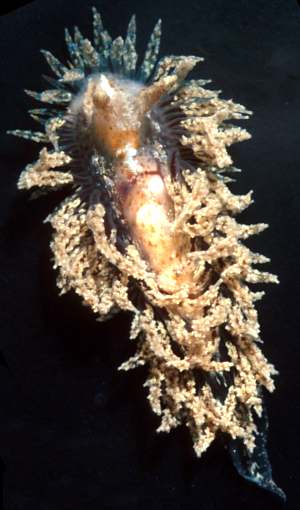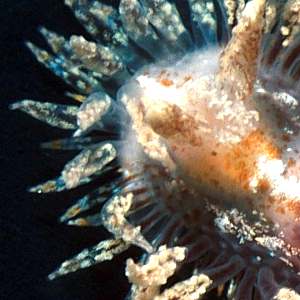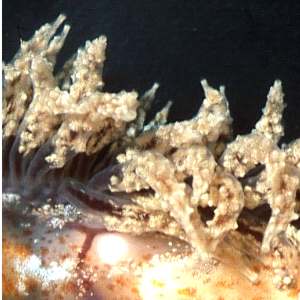Antipodean Janolus hyalinus revisited
November 15, 2002
From: Richard Willan

PHOTO: Point Danger, Torquay, Victoria, Australia. Low spring tide. 18 May 1984. 30 mm extended crawling length. Collected by Robert Burn and photographed by
Richard Willan.
Dear Bill,
I have attached a scan of a Janolus specimen from Victoria, sthn Australia, to indicate the variation within this species that you have on the Forum as Janolus sp. 5. Previously I had considered it was the European Janolus hyalinus, but now it seems it occurs only in southern Australia. This undescribed species has brown spots on its body and the cerata have a golden band subterminally which is most visible in those cerata that are not heavily marked with white pigment. The cerata seem to be more transparent in younger animals or in those that have regrown their cerata following autotomy. In this species, the tip of the cerata is blunt and flattened, resembling a miniature suction cap, and this tip is sometimes quite enlarged as in the specimen John Chuk photographed at Portsea Pier. The digestive diverticulum extends almost to the apex of each ceras, but not quite.
Another reason for posting this image is to point out differences between this species and the animal Andrew Green photographed from the Poor Knights Islands in northern New Zealand back in May 1999 that also had pustulose cerata [see message 1, message 2]. This species now seems not to be Janolus sp. 5, nor J. hyalinus, and it is definitely not J. novozealandicus. I now think this is an another entirely different (also undescribed) species The cerata have numerous blue and gold specks and they are plumper than those of Janolus sp. 5, the pustules on the cerata are sparser and the digestive diverticulum extends to the very apex of each ceras. The Poor Knights Islands support tropical nudibranch species that arrive as larvae from the north and this number is definitely increasing in recent years (a fact I attribute to global warming), so Andrew's Janolus might be yet another example. This would really be a case of "Murphy's Law" operating, where you posted an undescribed species on the Forum that nobody had ever seen before.
Richard Willan
Richard.Willan@nt.gov.au


Dear Richard,
Thanks for this photo. The anterior cerata very happily show the blue and gold bands which link this with John Chuk's photos of what looks on first sight a different species. I am glad you now agree with me that there are two unnamed species in the New Zealand - sthn Australian region, neither of which are Janolus hyalinus. I am not quite sure why you have invoked "Murphy's Law" to explain why I have posted 'an undescribed species on the Forum that nobody has ever seen before'. One of the aims of the Forum is to enable professionals and interested amateurs to share their 'puzzles' and 'interesting finds' with others. These Janolus species, although a bit confusing initially, are an excellent example of how sharing ideas and information can significantly advance our knowledge.
To save further confusion I have renamed Andrew Green's species from Janolus cf. hyalinus to Janolus sp. 6. Hopefully I have made all the necessary 'behind the scenes' changes. If by chance I haven't and someone notices a weird link, I would be very grateful if you could let me know.
Best wishes,
Bill Rudman
Related messages
-
Re: John Chuk's Janolus cf. novozealandicus
From: Richard Willan, June 10, 2001 -
Zephyrinid from Victoria, Australia
From: John Chuk, February 23, 2001
